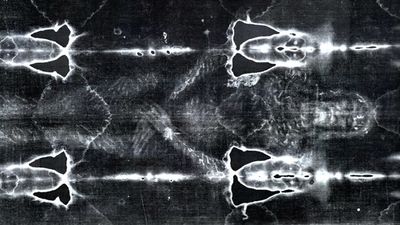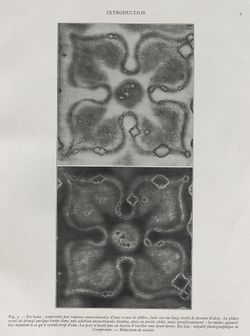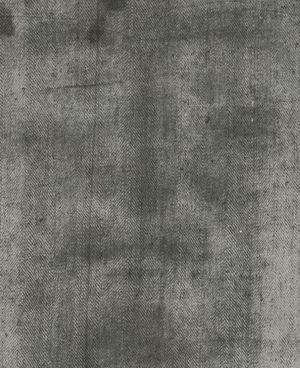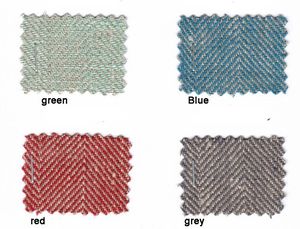Discussion:Suaire de Turin
The Ummans maintain that the real Sindon is kept secret in the Vatican because its scientific analysis from 1902 onwards would have shown the fabric to be impregnated with fresh, unclotted blood, indicating that Jesus did not die on the Cross.
The real Sindon would have been replaced by an artifact manufactured in 1927 and substituted for the authentic one from 1931.
It is this apocryphal copy that is now on public display in Turin. The photographs and analyses carried out since 1969 (Pellegrino), 1978 (STURP) and 1988 (carbon 14) would have been made on this apocryphal copy, leading to a number of confusions'
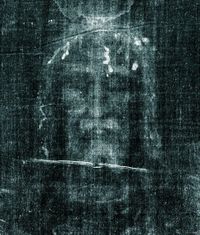
Sommaire
what is the Holy Shroud or Shroud of Turin?
The Turin Shroud, or Linceul de Turin, is a yellowed linen sheet 4.42 meters long by 1.13 meters wide showing the blurred image (front and back) of a man showing the traces of wounds consistent with crucifixion. It has been preserved since 1578 in the Guarini chapel of Turin's Cathedral of St. John the Baptist.
Since the representation depicts certain details of the Crucifixion of Jesus of Nazareth described in the canonical Gospels, it is the object of popular piety and is considered by the Catholic Church to be an icon. Some believers venerate it as an insignificant relic, the "Holy Shroud".
In 1898, Secondo Pia, an Italian lawyer and photographer, had the opportunity to photograph the Turin Shroud while it was on display in Turin Cathedral. When he developed the photographs, he was surprised to discover that the negative image of the shroud revealed far more detail than was visible to the naked eye. This discovery aroused great interest and paved the way for a series of in-depth scientific studies and research into the shroud.
The negative image obtained by Pia showed very precise anatomical details and facial and body features that seemed to match the accounts of the Crucifixion of Jesus of Nazareth as described in the Gospels. This revelation rekindled interest in the shroud and sparked intense debate about its authenticity and origin.
The relic escaped the flames of a fire in 1532, when a blaze ravaged the chapel where it was kept in Chambéry, France, and in 1997 when a fire broke out in the Guarini chapel of the Cathedral of St. John the Baptist in Turin.
See also: https://fr.wikipedia.org/wiki/Suaire_de_Turin
Authentication of the Holy Shroud by the Ummans
The Ummans authenticated this relic as early as 1987:
Beyond this authentication of the Holy Shroud, the Ummans also warn that this relic has been the object of fraud to confuse mankind in its history. The Ummans invite us to verify that Church figures were involved in the substitution of the authentic Holy Shroud by an apocryphal copy.
== Telephone calls about the Holy Shroud
From March 1987 to November 1988, the Ummans began an intense sequence of dozens of letters and 24 telephone calls to two Spanish recipients, Mr. Luis Jiménez Marhuenda and Mr. Jorge Barrenechea.
The subjects of the telephone conversations between the Ummans and the Spanish callers are numerous, but they frequently concern Jesus Christ and the denunciation of the Holy Shroud fraud.
On January 28, 1988, from 1.35pm to 1.50pm, the Ummans announced the dispatch of two important letters:
See also Compilation of extracts from telephone calls about the Holy Shroud
Letters about the Holy Shroud of Turin
Finally, Mr. Jorge Barrenechea will finally be the recipient of 6 important letters, namely:
1998, January, 10, 13 and 20: D 792-1 Les "Oemiiwoa "incarnations cosmiques impulsant l'évolution ( généralités)
1998, January, 20: D 792-2 Life and death of Christ
1988, November, 11: D505: How the Turin Sindon fraud was perpetrated.
1988, November, 11: D518: Gravity of the Turin Shroud fraud / Socio-political stakes of disclosure.
1988, November, 13: D490: Organization of a denunciation meeting concerning the Sindon [ Hotel Sanvy, Madrid ].
1988, November, 13: D499 : Scientific concept of Ommiwoa on planet Ummo - Explanation on scientific analyses of Sindon in 1988
Spanish recipients Antonio Ribera, Ignacio Darnaude, Juan Trigo Gandul will receive:
1988, November, 1: D 488 The fraud on the Turin Shroud (to Darnaude) / Explanation on the Oemmiwoa
See also Oemmiwoa letters from 1987 to 1988 - Holy Shroud
Fraud denunciation conference, Madrid, Hotel Sanvy, 1988
But most surprising of all was the Ummans' initiative in organizing a discreet conference in Madrid, at the Hotel Sanvy on Sunday November 20, 1988.
The historical background to the controversy and the Umma statements =
Jesus Christ would not have died when he came down from the cross
According to the Umma, Jesus of Nazareth was wrapped in a long cloth when he came down from the cross, but he was not dead. On the contrary, they recently clarified that he was under the influence of a powerful drug to simulate his demise. [1]
Receiving treatments including ointments made from aloe vera, Jesus is said to have awakened from his deep sleep while wrapped in this cloth or shroud. He would then have resumed his preaching shortly before experiencing a strange phenomenon described in the 1988 letters, namely ASNEEIIBIAEDOO
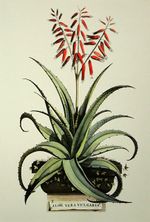
Faced with the historical facts of the controversy surrounding the authenticity of the Turin shroud, Umma's statements provide an alternative perspective. The relevance of their sindonological theses stems from an in-depth knowledge of the history of the Holy Shroud, particularly in modern times.
The shroud of this period (original for the sequel) would therefore bear the scientific proof that the official account of Christ's death would be erroneous, as Christ would not have died on the cross. Letters from 1988 such as D 792-2 also provide the conclusions of the investigations carried out by the Umma expeditionaries.
Indeed, the presence of non-coagulated blood would call into question whether Jesus died on the Cross. And French scientists would have understood this as early as 1902
1902: P. Vignon and R. Colson explained that Jesus did not die on the Cross
1902: P. Vignon and R. Colson would also have explained the origin of the imprint
However, from 1902 onwards, examination of the bloodstains on this shroud indicates that the person who bled (Jesus) had not died when it was wrapped, nor in the days that followed. The Ummans pay particular tribute to the seminal work of scientists such as Paul Vignon and René Colson
a challenge to the fundamental dogmas of the Church
Both Jesus' death on the Cross and the Resurrection episode are founding pillars for the Church's dogmas. The official version of the life of Jesus and therefore the fundamental interpretation of Christianity by the Vatican, but also by other churches, such as the Protestant and Orthodox Churches.
It was the earthquake produced by this questioning by Science as early as 1902 that triggered a series of events.
Observation of the Holy Shroud reveals the presence of fresh blood
The absence of linen strips (phakiai) in contradiction with Jewish funeral rites
The absence of linen strips on the Turin shroud can be seen as a departure from traditional Jewish funeral practices of Jesus' time, which has contributed to the debate about the shroud's authenticity and origin. The Ummans' explanation would shed new light on these debates.
Linen strips, or "phakiai", were indeed used in Jewish funeral practices of the time, and this is documented in various historical sources (Flavius Josephus and Philo of Alexandria) and religious texts, (Talmud and Midrash ) and finally concordant archaeological observations. Linen strips were often used to wrap the body of the deceased as part of Jewish burial rituals. After the body had been prepared, it was wrapped in linen strips to preserve and protect it during burial. This practice was seen as a sign of respect for the deceased and was an integral part of Jewish funeral rites at the time.
What's more, this difference contradicts the Gospel according to John (John 19:40): "So they took the body of Jesus, and bound it with bindings and spices, as was the custom for burial among the Jews."
Roman Catholic cardinals at the center of the fraud
The Ummans invite us to verify that Church figures were panic-stricken from 1902 onwards, and that a group of cardinals initiated a plot to solve the problem in the first place:
1902 and 1911: unsuccessful first attempt at fraud
Initially, between 1902 and 1911, the cardinals attempted to erase the traces of blood by damaging the authentic relic.
1911 to 1928: production of the definitive apocrypha
Following this highly problematic failure, the Cardinals are said to have embarked on a more methodical scientific study to analyze the technical challenges to be resolved.
After several attempts between 1911 and 1927, the forgers succeeded in producing an apocryphal copy of the authentic Shroud around 1927.
Multiple techniques used
The Ummans detail precisely the multiplicity of different techniques they would have analyzed on the apocryphal copy between 1927 and 1928, including:
| Description ( in D 505 ) |
|---|
| Selection of fabrics dating from 1220 from the Jaffa region (Palestine). |
| Use of an original scale copy of Secondo Pia's plates. |
| Treatment of the canvas with a metal bas-relief heated to varying temperatures (average 248°C, maximum 410°C). |
| Heating of the print for several months using an electric resistance plate. |
| Introduction of 2 coin designs that would not appear on the original authentic sindon. |
| Final touch-up with a gentle rubbing of the cloth. |
| Wash one part of the sheet with diluted sweat. |
| Wash other areas with solutions of varying concentrations of sulfuric acid in water. |
This leads them to explain:
Observable differences in fabric structure
The Ummans also provide precise parameters for distinguishing between the original Shroud and its apocryphal copy.
For the apocryphal copy, the forgers used fabric dating from 1220 from the Jaffa region (Palestine).
Furthermore, the fabric of the authentic Shroud could be dated to around the 1st century A.D., notably by Carbon-14 dating.
Photos taken by Giuseppe Enrie in 1931 actually show a "fishbone" fabric structure:
replacement of the original by the apocryphal copy circa 1929
The cardinals involved would then have replaced the original with a copy around 1929. Ummans are somewhat hesitant about this date:
The apocryphal copy was close enough to the authentic Shroud for the Cardinals, given the scientific knowledge and analysis techniques available at the time. But the evolution of knowledge and techniques was to prove unexpected and problematic for their plot.
According to the Ummans, the fabric displayed in public ostentations since 1931 is the apocryphal one.
What's more, the many photographs taken by professional photographer Giuseppe Enrie in May 1931 are not of the authentic Shroud, but of this copy. Thus, Enrie's photographs, which have served as references in sindonological studies for many years, would not be photographs of the authentic Holy Shroud. It's quite possible that this is also the case for the recent photographs taken in 1969 by Giovanni Battista Cordiglia (in color), in 2001 by Aldo Guerresci, and finally in 2008 by the company HAL9000 in Novara.
It would also be the apocryphal copy that would have been the subject of modern scientific analyses, notably those carried out in 1973 by the Pellegrino Commission, by the Shroud Research Project (S.T.U.R.P) between 1978 and 1980, and by laboratories in Arizona, Oxford and Zurick in 1988.- ↑ ( cf. 312-Stat-2; October 2021 )
